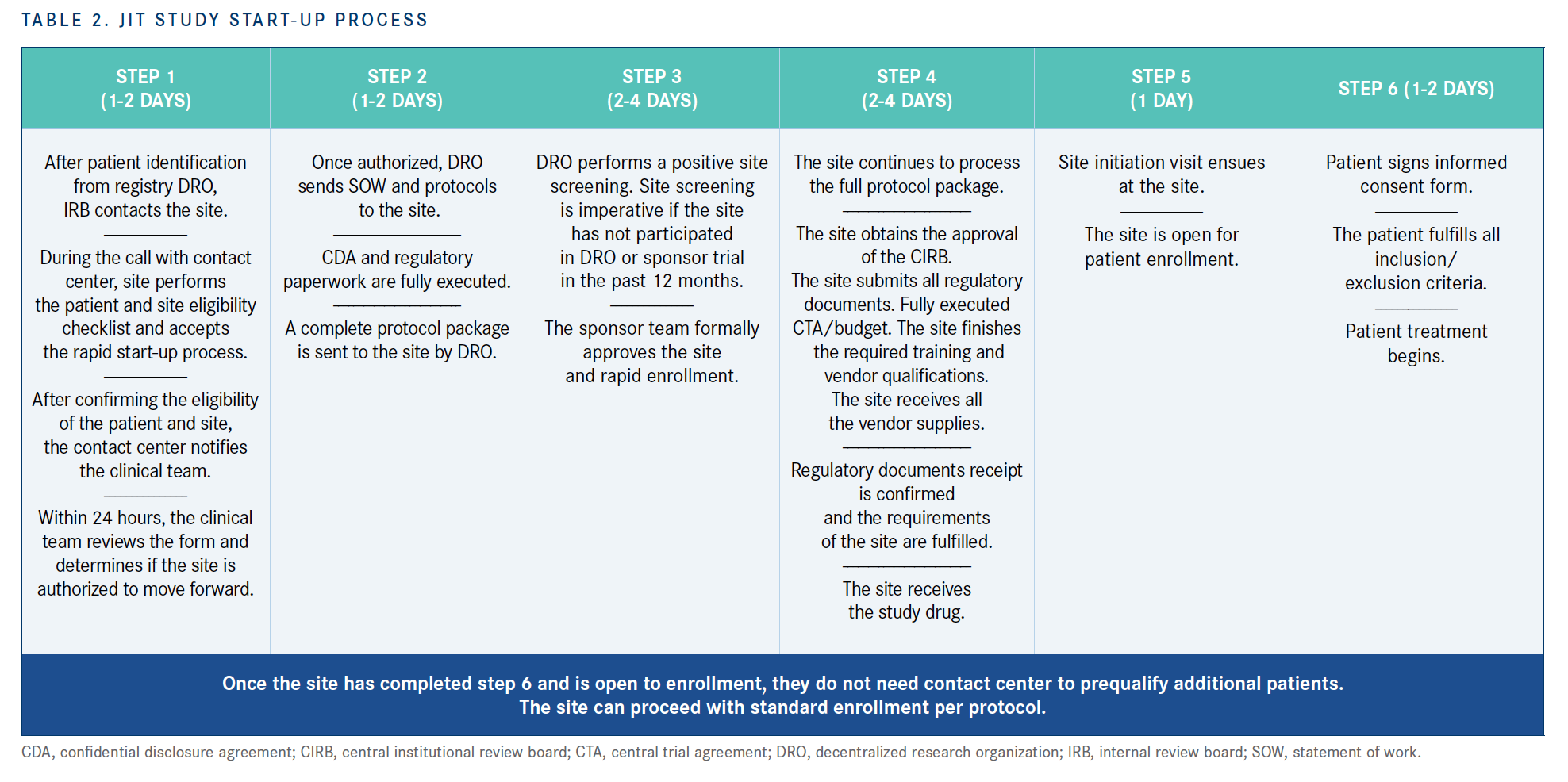Can Just-in-Time Clinical Trials Reduce Disparities in Participation?
Just-in-time trials are 1 tool capable of rapidly increasing access to clinical trials to develop drugs that treat the diverse and unique tapestry of patients across the United States, especially patients with more diverse racial, ethnic, and socioeconomic backgrounds.

The past 2 decades have witnessed rapid strides in the field of cancer medicine by understanding the complex interactions of epigenetics, genotype, germline mutations, environmental factors, and social determinants of health resulting in the evolution of the field of precision medicine (PM).1-3 This understanding has also led to emerging targeted therapies and the expansion of personalized medicine.1
Clinical trial accrual in adult cancer patients is less than 3% across the adult cancer patient population.4 The figures are even worse in minorities and women.5 In a 2020 analysis of the global participation in clinical trials, the FDA highlighted the vast difference and disparities between the enrolled participants. The FDA report revealed that out of close to 290,000 trial participants worldwide, 76% were White, 11% were Asian, and only 7% were Black.4 Comparing these statistics to the global population of 8 billion people, 60% of the participants reside in Asia, 16% in Africa, 10% in Europe, and approximately 8% in Latin America (World Population Review).6,7 Similarly, a review of 379 clinical trials funded by the US National Institute of Mental Health published in 1995-2004 found that all racial or ethnic groups except White individuals and African Americans were underrepresented, and only about 48% of the studies provided complete racial or ethnic information.2 Thus, data for global populations are lacking, and current guidelines and clinical decisions are based on insufficiently diverse trials and studies.

Existing models of clinical trials programs lean on large academic centers and tertiary care centers to execute clinical trials. This has inherent challenges when it comes to improving diversity. It can also make disparities worse. More than 70% of the US population lives more than 2 hours from large academic and tertiary institutions, making localized participation challenging for many. Additional barriers include time away from work, child care needs, and transportation costs.
Implications of Lack of Diversity in Clinical Trials
When used in a real-world population, newer drugs that are developed based on clinical trials that lack these types of diversity can lead to treatments that are not effective universally and can carry unexpected toxicities due to biological differences in genomic map and pharmacogenomics in underrepresented minorities. Pharmacological difference based on sex and race may lead to either reduced activities or increased toxicities.8-9 Females have a 1.5- to 1.7-fold greater risk of developing an adverse drug reaction. Several drugs have been withdrawn from the market for sexbased adverse events (AEs).10 The cancer drug fluorouracil has different toxicity profiles and AEs. These AEs were observed at a higher rate in African American individuals.10 Ixazomib (Ninlaro), approved by the FDA in 2015 for the treatment of multiple myeloma, had only 1.8% Black participants in the phase 3 clinical trial despite African Americans having higher incidence and prevalence of this disease than European Americans.11
Establishing diversity in clinical trials is essential to achieving health equity by ensuring historically underrepresented patient populations have equal access to and efficacy from new and investigative therapies that can help improve outcomes. Taking a real-world data (RWD)–based approach can help unlock the ability to find new sites and diverse patient populations while keeping the focus on the trusted patient-provider connection often found in community practices. This can help bridge the current diversity gaps.
Advantages of Using Just-in-Time Clinical Trials
The COVID-19 pandemic has created an alternative path to rapid accrual using data and remote monitoring technologies to improve trial accrual efforts and lead to successful completion, and subsequent drug approvals. Expanding the availability of clinical trials to providers irrespective of their academic and institutional affiliations could expand the diverse populations who might benefit from the treatment. This can be accomplished by establishing a RWD registry as the first step.
Just-in-time trials (JITs) create an immediate opportunity to advance a well-defined path forward to reducing cancer health disparities by helping all patients increase access to clinical trials for precision medicines— especially patients with more diverse racial, ethnic, and socioeconomic backgrounds. JIT trials unlock opportunities hiding in plain sight, leveraging patient registries using RWD and real-world evidence (RWE), patient-centered technologies coupled with standardized processes, remote support, centralized internal review boards (IRBs), and no redundancy (TABLE 1). JIT is about modernizing and changing the way clinical trial sponsors think about and approach clinical trials today.
The concept of developing JIT trials is a recent one. It is particularly well adopted as a companion to the implementation of PM. To initiate them, pharmaceutical companies would need to open a study site only where patients are located, rather than opening multiple sites, which adds a burden to already stretched resources. JIT is based on providing the right access to a trial at the right time rather than opening hundreds of sites and not accruing a single patient. JIT reduces demands for huge paperwork for each study and labor-intensive archaic paperwork creating an unnecessary burden on sites with limited resources. The biggest argument for the use of JIT trials is reducing costs.
Reducing Racial Disparities in PM
The frequency and distribution of cancer health disparities (CHDs) are uneven across races. It is undisputed that African Americans, Hispanics and non-White individuals are disproportionately burdened by 4 drivers of CHDs: access to screening, testing, clinical trials, and treatment. There are over 45 types of cancer that do not have any recommended screening methods; there are no screens commercially available for melanoma or for cancer of the stomach, kidney, pancreas, or ovaries, and limited screens are available for lung cancer. Seventy-one percent of cancer-related deaths in the US are in cancers with no recommended screening guidelines for the broad population. Increasing access to both screening and testing is a strategic imperative only if they are used. JIT trials begin with creating RWD by harnessing demographic, clinical, racial, socioeconomic, pathological, radiological stage, genomics, biomarker, and pharmacogenomics data in ways that affect medical management in over 30% of patients.6,7 This is how we make precision medicine more precise.
The next step is for contract research organizations (CROs) to harness this kaleidoscope of well-phenotyped patient data and systematically increase accrual of minorities into clinical trials. Reducing CHDs by increasing access to screening and access to testing simultaneously creates a positive feedback loop that drives increased adoption of clinical trials, even more so JITs. Pharmaceutical manufacturers now use data from molecularly targeted biomarker testing, incorporated in patient registries using RWE to improve standard-of-care treatment, develop new, novel targeted therapies, and address health care disparities. This is measurable progress for all stakeholders in cancer care.
Accessing JIT Provider Networks
JIT provider networks are critical infrastructure and must be used to reduce CHDs by increasing access to clinical trials. Addressing widespread CHDs requires CROs and clinical trial sponsors to adopt and use JIT provider networks (FIGURE). Proprietary patient registries, with the help of the pharmaceutical industry or decentralized research organizations (DROs), can screen for patients, process paperwork, and enroll patients into trials from all participating sites.
The opportunity to avoid considerable fixed costs, expenses, and under- or no enrollment at multiple sites creates an attractive value proposition for all parties involved. The acceleration of all aspects of clinical trial site readiness is unparalleled through a differentiated JIT study start-up process.


JITs can accomplish in 2 weeks what many trial sites are unable to accomplish in 2 months.
JIT trials can collapse and consolidate into days—and into 6 steps or less—a systematic process that begins first by fast-tracking patients identified from registry, confirming the eligibility of the patient, and coordinating communications with the clinical team to rapidly assess and evaluate authorization for participation in the clinical trial (TABLE 2).
Next, for step 2, upon authorization, the DRO sends scope of work and protocols to the site, preceding the execution of confidential disclosure agreements (CDAs) and all regulatory paperwork.
Now, a complete protocol package is sent to the site by the DRO. By the fifth or sixth day, the DRO performs a positive site screening. This step is imperative if the site has not participated in DRO or sponsor trial in the past 12 months. The sponsor team will now approve or reject the site and begin rapid enrollment of patients.
In approximately 1 week, the site can process the full protocol package and obtain approval from centralized IRB, as well as execution of clinical trial agreement, budget approval, and submission of all regulatory documents. The site is now ready for required training and vendor qualifications as well as delivery of supplies.
The site is notified of regulatory documents receipt, and that all requirements are fulfilled. Generally, in less than 10 days, the site is ready to receive the study drug.
Upon receipt of the study drug, the site is ready for step 5, a site initiation visit; following this, the site is open for enrollment.
Finally, the site is ready for patient authorization of informed consent, upon which the patient fulfills all inclusion/exclusion criteria, and, in less than 14 days, patient treatment begins.
In summary, JIT trials provide a rapid solution to a series of problems facing clinical trial sponsors, oncologists, patients, and society.
In what ways might we reduce the 4 drivers of cancer health disparities in a scalable, systematic, and repeatable way? True diversity in clinical trials demands doing things differently today, not tomorrow or in the future.
The promise of PM requires making PM more precise, and JIT trials are 1 tool capable of rapidly increasing access to clinical trials to develop drugs that treat the diverse and unique tapestry of patients across the US, especially patients with more diverse racial, ethnic, and socioeconomic backgrounds.
REFERENCES:
1. National Institutes of Health. What is PM? Medline Plus. Accessed July 23, 2022. https://bit.ly/3Q0OzFD
2. Khoury MJ, Galea S. Will precision medicine improve population Health? JAMA. 2016;316(13):1357-1358. doi:10.1001/jama.2016.12260
3. Khoury MJ, Iademarco MF, Riley WT. Precision public health for the era of precision medicine. Am J Prev Med. 2016;50(3):398-401. doi:10.1016/j.amepre.2015.08.031
4. 2015–2019: drug trials snapshots summary report. US FDA. Accessed July 23, 2022. https://bit.ly/3PHlwaB
5. Shavers VL, Brown ML. Racial and ethnic disparities in the receipt of cancer treatment. J Natl Cancer Inst. 2002;94(5):334-357. doi:10.1093/jnci/94.5.334.
6. Anderson GD. Sex and racial differences in pharmacological response: where is the evidence? pharmacogenetics, pharmacokinetics, and pharmacodynamics. J Womens Health (Larchmt). 2005;14(1):19-29. doi:10.1089/jwh.2005.14.19
7. Zopf Y, Rabe C, Neubert A, et al. Women encounter ADRs moreoften than do men. Eur J Clin Pharmacol. 2008;64(10):999-1004. doi:10.1007/s00228-008-0494-6.
8. Mak WW, Law RW, Alvidrez J, Pérez-Stable EJ. Gender and ethnic diversity in NIMH-funded clinical trials: review of a decade of published research. Adm Policy Ment Health. 2007;34(6):497-503. doi:10.1007/s10488-007-0133-z.
9. McCollum AD, Catalano PJ, Haller DG, et al. Outcomes and toxicity in african-american and caucasian patients in a randomized adjuvant chemotherapy trial for colon cancer. J Natl Cancer Inst. 2002;94(15):1160-1167. doi:10.1093/jnci/94.15.1160.
10. Drug Trials Snapshots: Ninlaro. U.S. FDA. Accessed July 23, 2022. https://bit.ly/3PYarl9

Survivorship Care Promotes Evidence-Based Approaches for Quality of Life and Beyond
March 21st 2025Frank J. Penedo, PhD, explains the challenges of survivorship care for patients with cancer and how he implements programs to support patients’ emotional, physical, and practical needs.
Read More